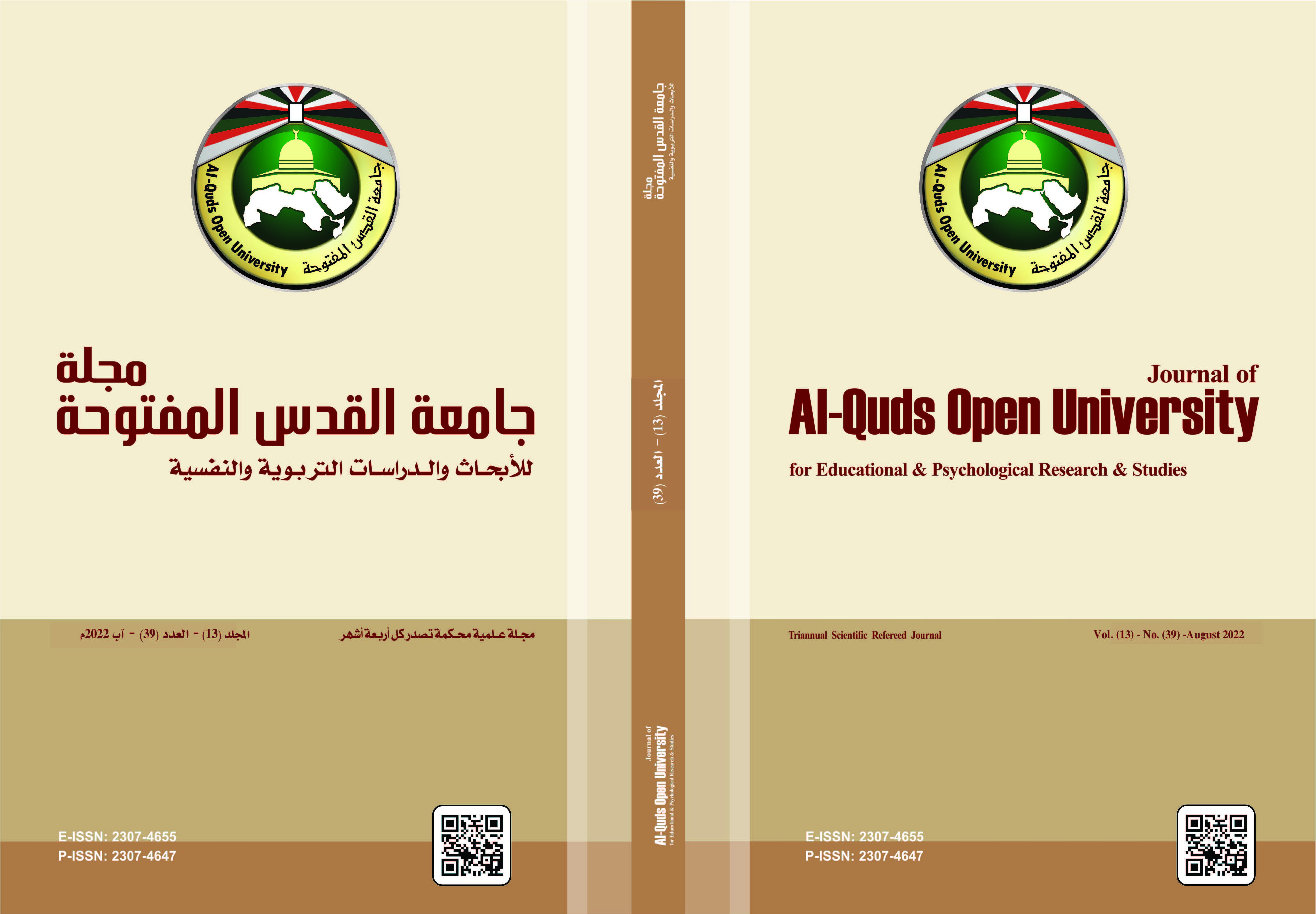تحليل محتوى لمفردات كتاب اللغة الانجليزية Action Pack6 للصف السادس الأساسي في الأردن
DOI:
https://doi.org/10.33977/1182-013-039-015الكلمات المفتاحية:
تحليل المحتوى، المفرداتالملخص
هدفت هذه الدراسة إلى البحث في مدى ملاءمة المفردات الموجودة في كتاب الصف السادس الأساسي (Action Pack 6) للمواضيع الرئيسة المطروحة في الوحدات الدراسية في كتاب الطالب ومدى ملاءمة عرض هذه المفردات الجديدة في السياق وفي المواقف لمستوى هؤلاء الطلبة. وقام الباحث بتحليل محتوى وحدات الكتاب العشرين من خلال معيارين أساسيين وهما مدى مناسبة حِمل المفردات ومدى مناسبة المفردات لمستوى طلاب الصف السادس الأساسي. وتكونت فئات التحليل من: اختيار المفردات المناسبة لموضوع الدرس، وتقديم المفردات في السياق والموقف المناسب، وكانت وحدة التحليل هي الكلمة. جُمعت البيانات وحُللت وأظهرت نتائج الدراسة مناسبة حِمل المفردات لمستوى الطلبة ومناسبتها أيضا لمواضيع الوحدات الدراسية. وأظهرت نتائج الدراسة أيضا أن المفردات الموجودة في كتاب الطالب للصف السادس الأساسي كانت مناسبة للسياق والحياة الواقعية للطلبة.
المراجع
Al Khazaleh, S. (2020). A content analysis of the authenticity of the reading texts in the seventh grade EFL book in Jordan. International Online Journal of Education and Teaching (IOJET), 7(3). 977-990.
Alqahtani, M. (2015). The importance of vocabulary in language learning and how to be taught. International Journal of Teaching and Education, III(3), pp. 21 - 34.
Al-Smadi, S., Bataineh, F., & AlHawamdeh, M., (2021). A Content Analysis of the Pronunciation and Spelling Activities in Action Pack Ten. Jordanian Applies Sciences Journal, 28 (2), pp. 1-14.
Berelson, B. (1952). Content analysis in communication research. Glencoe, IL: Free Press.
Berne, J. I. & Blachowicz, C. L. Z. (2008). What reading teachers say about vocabulary instruction: voices from the classroom. The Reading Teacher, 62 (4), pp. 314 - 323.
Brown, H. (1987). Principles of language learning and teaching (2nd ed.). New Jersey: Prentice-Hall.
Decarrico, J. S. (2001). Vocabulary Learning and Teaching. Celce-Murcia, M. (ed.). Teaching English as a Second or Foreign Language, pp. 285-299. Boston: Heinle & Heinle.
Folse, K. S. (2004). Vocabulary myths: Applying second language research to classroom teaching. Ann Arbor, MI: The University of Michigan Press.
Gu, Y. (2003). Vocabulary learning in second language: person, task, context and strategies. Electronic Journal TESL-EJ, 7(2), pp. 1-26.
Islim, S. A. (2019). A Content Analysis of Authentic Reading Activities in the Jordanian English Textbook Action Pack Twelve Matching the General Guidelines and General and Specific Outcomes. Journal of Educational and Psychological Sciences,3 (31), pp.194-234.
Jakovos, T. (2000). “Selecting an English Course Book: Theory and Practice”. Theory & Practice in Language Studies, 1 (7).
Laufer,B. (1997). The Lexical Plight in Second Language Reading. In Huckin,T.& Coady ,J. Second Language Vocabulary Acquisition :A rationale for Pedagogy p.20, Cambridge university press.
Magableh, W. (2000). An evaluation of the functional English language textbook for the commercial first secondary class in Jordan. Unpublished Master Thesis. Yarmouk University, Irbid, Jordan.
Marion, T. (2008). The effect of gestures on second language memorization by young children. Gesture, John Benjamins Publishing, 8 (2), pp. 219 - 235.
Maximo, R. (2000). Effects of rote, context, keyword, and context/ keyword method on retention of vocabulary in EFL classroom. Language Learning, 50(2), pp. 385-412.
Meara, P. (1980). Vocabulary acquisition: A neglected aspect of language learning. Language Teaching and Linguistics, 13, pp. 221-246.
Nation, P. (2001). Learning vocabulary in another language. Cambridge, UK: Cambridge University Press.
Prator, C.H., & Celce-Murcia, M. (1979). An outline of language teaching approaches. In Celce-Murcia, M. and L. McIntosh (Eds.), Teaching English as a second or foreign language (pp. 3-16). New York: Newbury House. Skierso, A.(1991). Textbook Selection and Evaluation’. In M. Celce-Murcia (Ed), Teaching English as a Second or Foreign Language’ (pp.432-453). Boston: Heinle and Heinle.251- 255
Read, J. (2000). Assessing vocabulary. United Kingdom: Cambridge University Press.
Skierso, A. (1991). Textbook Selection and Evaluation’. In M. Celce-Murcia (Ed), Teaching English as a Second or Foreign Language’ (pp.432-453). Boston: Heinle and Heinle.251- 255
Sothan, S. (2015). Exploring English Language Needs According to Undergraduate Students and Employers in Cambodia. International Journal of Linguistics and Communication, 3(1), pp. 87-96.
Susanto. A. (2016). How English Learner Succeeded in Difficult Circumstances. Journal Pendidian UNSIKA, 4(2), pp. 135-148.
Thorbury, S. (2002). How to teach vocabulary. England: Pearson Education Limited.
Walters, J. M. (2004). Teaching the use of context to infer meaning: A longitudinal survey of L1 and L2 vocabulary research. Language Teaching, 37(4), pp. 243-252.
Yang, Y. F. (1997).The study on the reading process of English Learners’ words. The 14th session of the China Chinese Language Teaching Seminar, pp. 183-197.
Zawahreh, F.(2012). A content Analysis of the vocabulary items in students’ books of Action Pack Seven as a textbook for teaching English as a foreign language in Jordan. Continental J. of Education Research , 5 (1), pp. 34 – 45.
Zimmerman, C. B. (1997). Historical trends in second language vocabulary instruction. In J. Coady, & T. Huckin (Eds.), Second language vocabulary acquisition: A rationale for pedagogy (pp. 5-19). Cambridge, UK: Cambridge University Press.
التنزيلات
منشور
كيفية الاقتباس
إصدار
القسم
الرخصة
-
- الالتزام التام بأخلاقيات البحث العلمي.
- الالتزام التام بحقوق الملكية الفكرية.
- حقوق الطبع والنشر تؤول للمجلة.
- الحصول على موافقة المجلة لإعادة نشر البحوث أو ترجمتها.
- الالتزام التام بتعليمات هيئة تحرير المجلة.







2.png)






_2.png)

